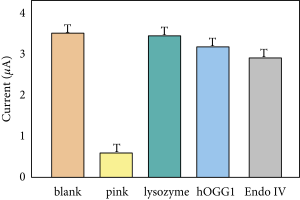Mere days after tweets went viral pointing out that the purported error bars in one figure of a paper were really just the capital letter T, the publisher has marked it with an expression of concern. [12/22/22: The paper has now been retracted; see an update on this post.]
And that’s not all that’s strange about the paper.
The July 2022 article, “Monitoring of Sports Health Indicators Based on Wearable Nanobiosensors,” was published in a special issue of the journal Advances in Materials Science and Engineering, a Hindawi title.
The article purports to show that using nanoparticles can better measure the biochemical fitness levels of elderly people than other methods.
But astute readers on PubPeer and Twitter noticed a figure with capital letter T’s standing in for error bars, which are used to show the level of uncertainty in a statistical measurement. Those T’s appear simply to be plopped on top of rectangles in a bar graph, with no statistical meaning at all.
The online attention began in earnest on November 28th.
The fishy error bars drew lots of derisive attention.
The article’s oddities merely began with those capital Ts, readers noticed as they looked more closely. On PubPeer, sleuth Elisabeth Bik noted that the authors randomly included results from a survey of the fitness habits of 210 elderly people in China – which mentions playing chess and cards as a form of exercise – that they did not mention in the paper’s title, abstract, or conclusion.
And there’s a strikingly long section that details how to solve a mathematical equation, with possibly incorrect notation
There are odd citation choices, too, as PubPeer commenters note, such as a reflection on the cardiovascular health of adolescents and the use of nanomaterials to measure chicken breast freshness.
Several Twitter commenters and one on PubPeer also noted that the article’s Data Availability statement – “Data sharing is not applicable to this article as no datasets were generated or analyzed during the current study” – is questionable, perhaps unusually honest.
The article’s lead author, Binghong Liu of Kunsan National University in Korea, did not reply to a request for comment.
The day after the tweet about the error bars, journal publisher Hindawi responded that they would be issuing an Expression of Concern.
On December 1 Hindawi published the Expression of Concern, which reads in full:
Advances in Materials Science and Engineering would like to express concern with the article titled “Monitoring of Sports Health Indicators Based on Wearable Nanobiosensors” [1]. Concerns have been raised regarding the underlying data and the error bars in Figure 9, as well as the methodology and the validity of the data availability statement.
The publisher is investigating these concerns and will revisit this article with any necessary post-publication amendments.
As scientific sleuth Nick Wise has noted, Hindawi’s special issues can become dumping grounds for articles from paper mills, as peer review is outsourced to the organizing editors.
In September, Hindawi and its parent company Wiley announced plans to retract more than 500 papers, after discovering manipulated peer review in a journal special issue.
Wiley seems concerned about the reputational costs of publishing shoddy science, noting in its 2022 SEC filing, “Adverse publicity could negatively impact our reputation, which could adversely affect our consolidated financial position and results of operations.”
Like Retraction Watch? You can make a tax-deductible contribution to support our work, follow us on Twitter, like us on Facebook, add us to your RSS reader, or subscribe to our daily digest. If you find a retraction that’s not in our database, you can let us know here. For comments or feedback, email us at [email protected].

“The online attention began in earnest on November 28th.”
Did you mean to illustrate this with the November 28 tweet from “Cheshire”, rather than with the November 29 tweet from Josemari Feliciano?
https://twitter.com/Thatsregrettab1/status/1597078394348670976
I think Dr. Feliciano got much more attention on Twitter than the imaginary cat. In any case, I understand RW sometimes avoids identifying anonymous or pseudonymous people to protect their virginity. I mean identity.
This has now been retracted.
https://twitter.com/Thatsregrettab1/status/1605783108334358529?s=20&t=_brKzqFW_NGldPzLpR1D5A
Very odd. I prefer a capital I in my own work.
That way you express the +/- uncertainty all with one letter. Way better than T.
Looks like a AI generated paper hahaha
This is tragicomic and hilarious. I wonder if the author did everything just to troll.
This gives a new meaning to the T-test
Based on the descriptions of errors and weird crap in this paper by RetractionWatch (my new favorite feed to follow!) that someone planted this random piece to see if anyone was watching. But then again, the author hasn’t opined yet that it isn’t his
This is really strange. The corresponding author of this article, Binghong Liu, is not listed as a faculty in Kunsan National University in Korea. The email address for correspondence is “[email protected]”, which indicates a university email address in China for someone named Sunli Wei. It all seems quite fake.
And what about the peer reviewers and editor? How could these errors not be detected in the review process? Maybe there actually wasn’t a review process? Gross incompetence either way…